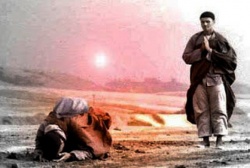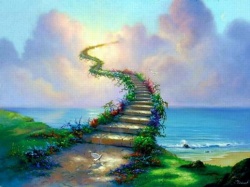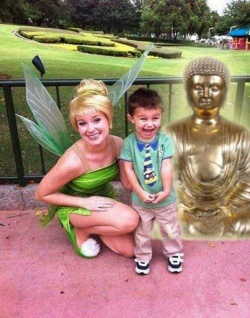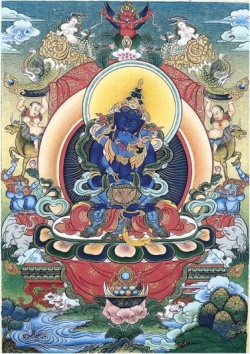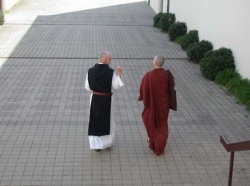Jambudvipa

Jambudvipa (Skt. Jambudvīpa; Tib. འཛམ་བུའི་གླིང་, Dzambuling; Wyl. ‘dzam bu gling) — one of the four continents, which is situated to the south of Mount Meru.
Its shape is trapezoidal or resembling the shape of an axe-head. It is the human world in which we live.
Jambudvīpa or Jambudīpa (Jpn: 閻浮提 Enbudai) is located in the south and is the dwelling of ordinary human beings.
It is said to be shaped "like a cart", or rather a blunt-nosed triangle with the point facing south.
(This description probably echoes the shape of the coastline of southern India.)
It is 10,000 yojanas in extent (Vibhajyavāda tradition) or has a perimeter of 6,000 yojanas (Sarvāstivāda tradition) to which can be added the southern coast of only 3 1⁄2 yojanas' length.
The continent takes its name from a giant Jambu tree (Syzygium cumini), 100 yojanas tall, which grows in the middle of the continent.
Every continent has one of these giant trees.
All Buddhas appear in Jambudvīpa.
The people here are five to six feet tall and their length of life varies between 10 to power 140 years (Asankya Aayu) and 10 years.
“Since this continent is adorned by a Jambubriksha jambu tree, it is known as the 'Continent of Jambu', or Jambudvipa.
The jambu tree is presumed by some to be the rose-apple tree (Eugenia jambolana).
More recent scholarship suggests that it may be a variety of plum.
However, legend says that only one jambu tree exists, which is not visible to ordinary persons but only to enlightened beings.”[1]
Alternative Translations
Footnotes
- ↑ Myriad Worlds, footnote 16, page 266.
Further Reading
- Jamgön Kongtrul, Myriad Worlds (Ithaca: Snow Lion, 1995), pages 112-113 & 131-134
Source
閻浮提 ・ 贍部洲 (Skt; Pali Jambudipa; Jpn Embudai or Sembu-shu)
One of four continents situated in the four directions around Mount Sumeru, according to the ancient Indian worldview.
Jambudvipa is the southern continent.
Jambu (or jambu ) is the name of a tree said to abound in Jambudvipa; dvipa means continent.
The shape of Jambudvipa is that of an almost equilateral triangle (precisely, a trapezoid whose southern end is far narrower than its northern end).
That is, the northern part of the continent is broad, tapering to a very narrow breadth in the south, a shape that suggests the Indian subcontinent.
In the northern part of Jambudvipa are the Snow Mountains, and to the north of the Snow Mountains lies Heat-Free Lake (also known as Anavatapta Lake).
The four great rivers of the Ganga, Sindhu, Vakshu, and Shitaoriginate from Heat-Free Lake and nurture the soil on Jambudvipa.
Mount Fragrant stands to the north of Heat-Free Lake.
Within Jambudvipa, there are sixteen great states, five hundred middle-sized states, and a hundred thousand small states (ten thousand small states according to another source).
The joys of Jambudvipa are fewer than those of the other three continents, for this continent is populated with people of bad karma.
It is said, therefore, that the Buddhas appear only in Jambudvipa in order to save the people.
Source
The Wonderland
At that time, Jambudvipa with all its [area of] ten thousand yojanas (a measurement approximately equal to seven miles) will be similar to the kingdom of Ketumati, being as prosperous as a Wedding house in season.
In these kingdoms, men and women will wash and bathe in ponds with banks of white sands upon which stairs made of the seven types of gems lead down.
These ponds will be frequented by swans and other birds and will always be covered by five types of water lilies.
People will wear heavenly scents and creams, wreaths of divine Flowers, selected ornaments and adorn themselves with garments and Clothes freely given by the Kalpa v.rk.sas (heavenly wishing trees which appear during the first phases of a Kalpa during the time of an Enlightened Buddha that provide for all human material wants).
They will enjoy the taste of heavenly-scented rice, sit and lie on comfortable beds with heavenly bedspreads, sleep while listening to music and watch the Dancing of artists who resemble the artists in Heaven.
They will awaken from sleep hearing music and see their Wealth and comforts by the Light of lamps burning with scented oil.
They will be especially happy when they see their great Wealth of cash, grains, Elephants, horses, servants and labourers.
As their minds will be full of Happiness, they will enjoy this Life full of luxury and comfort.
None of them will suffer from the ninety-eight or ninety-nine types of illness nor from the two hundred and three accidents.
Their bodies will be as healthy as the gods. As it has been said:
The people of Jambudvipa will be rich and prosperous.
They will always be happy and gay, peaceful in Mind, enjoying the five types of comforts, adorning their bodies with various ornaments which, devoid of all ailments, will shine like the bodies of the gods.
Source
In kamadhatu is Mount Meru which is surrounded by four islands.
The southernmost island is called ~ Jambudvipa ~ (or Rose Apple Island).
This is where humans live and notably is the only location where a being may become Enlightened.
It is a fortunate Rebirth that brings us to this human Body, that brings us to ~ Jambudvipa ~.
It is here that we may receive the gift of Dhamma, come to understand and know The Four Noble Truths,
The Eightfold Path, realize Liberation from the Wheel of Wandering On...
Source
movies.groups.yahoo.com/neo/groups/Jambudvipa
Jambu Dwipa – India or Ancient Bharata
Puranic description as per Hindu cosmology
According to Puranic cosmography, the Earth is divided into seven concentric island continents (sapta-dvipa vasumati) separated by the seven encircling oceans, each double the size of the preceding one.
The seven continents of the {{Wiki|Puranas]] are stated as
Shakdvipa, and
Seven intermediate oceans consist of salt-water, sugarcane juice, wine, ghee, curd, milk and water respectively.
Continent Jambudvipa (Indian Blackberry Island), also known as Sudarshanadvipa, forms the innermost concentric island in the above scheme.
Its name is said to derive from a Jambu tree (another name for the Indian Blackberry, a kind of black plum).
The fruits of the Jambu tree are said to be as large as Elephants and when they become rotten and fall upon the crest of the mountains, a river of juice is formed from their expressed juice.
The river so formed is called Jambunadi (Jambu river) and flows through Jambudvipa, whose inhabitants drink its waters.
Insular continent Jambudvipa is said to comprise nine varsas (zones) and eight significant mountains.
Markandeya Purana portrays Jambudvipa as being depressed on its south and north and elevated and broad in the middle.
The elevated region forms the varsa named Ila-vrta or Meruvarsa.
At the center of Ila-vrta lies the golden Mount Meru, the king of mountains and the support of the planet Earth.
On the summit of Mount Meru is the vast city of Lord Brahma, known as Brahmapuri.
Surrounding Brahmapuri are the cities of Lord Indra and of seven other devatas or demigods.
The varsas of
Uttarakuru (or Shringashaka)
are said to lie on the north, those of Hari, Kimpurusha and Bharata on the south and of Ketumala and Bhadrasva on the west and east sides of Mount Meru respectively.
The mountains named Nishada, Hemakuta and Himavan (Himalaya) lie on the south, mountains Nila, Sveta and Sringavan on the north, those of Malayavat and Gandhamadana on the west and east direction of Mount Meru respectively.
The geographical description of the Jambudvipa is given in great detail in Bhishmaparva of the Mahabharata and several {{Wiki|Puranas]].
Markandeya Purana and Brahmanda Purana divide Jambudvipa into four vast regions shaped like four petals of a Lotus with Mount Meru being located at the center like a pericarp.
The city of Brahmapuri is said to be enclosed by the river Ganga, known as Akash Ganga.
River Ganga is said to issue forth from the foot of Lord Vishnu and after washing the lunar region falls “through the skies” and after encircling the Brahmapuri “splits up into four mighty streams”, which are said to flow in four opposite directions from the landscape of Mount Meru and irrigate the vast lands of Jambudvipa.
River Sita irrigates the Bhadrasva varsa, river Jambunadi streams through the Ketumala varsa, river Alakananda flows through the Bharata varsa and river Bhadra washes the lands of the Uttara-Kuru varsa.
Real World identification
So far there is no satisfactory identification of all zones (varsas) of Jambudvipa.
The Vayu Purana furnishes some details of the mountain ranges, valleys and river systems of the geographical region of Jambudvipa making it possible to identify some of their geographical features.
- Mount Meru (or Sumeru) is identified with the vast Nagard Sarovar in the center of the modern Pamir mountain range.
- Bhadrasva varsa probably corresponds to the major part of Xinjiang province of China and the region lying to its east.
- Uttara-Kuru varsa is the region to the north of the Pamirs. It probably includes the north-western parts of Xinjiang province of China, the Tien Shan region, and most parts of Kyrgyzstan.
- Ketumala varsa is said to be the region spanned by the Amu Darya, and therefore may correspond to western Turkmenistan, north-west Afghanistan (ancient Bactria) and north-east Iran.
- Hari varsa is probably represented by western Tibet.
- Bharata varsa undoubtedly stands for the whole undivided India.
- Ila-Vrta varsa (Meruvarsa) is the mountainous region around the central point of Meru. It probably includes the Pamirs, Badakshan, parts of Kashmir, North-West Frontier region and north-east Afghanistan, etc.
Other varsas of Jambudvipa has not been identified.
As regards the Dvipas or insular continents:
- The Shakadvipa (the vast Scythe region) was identified by some as north Turkmenistan, Uzbekistan and Kazakhstan and some regions to north and west of the Caspian Sea.
- The author of Vayu Purana uses the name Kumuda-dvipa for Kusha-dvipa.
Kumuda is also a Puranic name of a mountain forming the northern buttress of Mount Meru (i.e. Pamirs).
In anterior Epic Age Kumuda was the name given to high table-land of the Tartary located to north of the Himalaya range.
Thus, the Kumuda-dvipa lay close to the Pamirs.
Some scholars connect this Kumuda (the Komdei of Ptolemy, probably Kamdesh from Kamboj-desh?) with ancient Iranian Kambojas.
- The river Kurumu (modern Kuram) on south of river Kubha (Kabol) is stated to be flowing through the Plaksa-dvipa of the Puranic accounts.
Hence the Plaksa-dvipa may have been the region lying to west of the Indus River probably comprising territories of Iran, middle and southern Afghanistan and parts of Pakistan, etc.
- The Pushkaradvipa has been identified by some as the region lying between China and Mangala (perhaps China and Mongolia) based on the evidence of medieval era Muslim scholar Al-Biruni.
There has been an attempt to plot the concentric continents on solar system.[6] Their identification is difficult since, according to Matsya Purana, they are of super-Human nature.
The common names of the dviipa-s, having their vars.a-s (9 for Jambu-dviipa, 7 for the other dviipa-s) with a mountain and a river in each vars.a, is given in several Puraan.a-s .
There is a distinct set of names provides, however, in other Puraan.a-s .
The most detailed geography is that described in the Vaayu Puraan.a .
In Buddhism
The Buddhist cosmology divides the bhuma??ala (circle of the Earth) into three separate levels:
Rupadhatu (Form realm), and
In the Kamadhatu is located Mount Sumeru which is said to be surrounded by four island-continents.
“The southernmost island is called Jambudvipa”.
The other three continents of Buddhist accounts around Sumeru are not accessible to humans from Jambudvipa.
Jambudvipa is shaped like a triangle with a blunted point facing south.
In its center is a gigantic Jambu tree (rose-apple) from which the continent takes its name, meaning “Jambu Island”.
Jambudvipa is the region where the humans live and is the only place where a being may become Enlightened by being born as a human being.
It is in Jambudvipa that one may receive the gift of Dharma and come to understand The Four Noble Truths, the Noble Eightfold Path and ultimately realize the Liberation from the cycle of Life and Death.
Another reference is from the Buddhist text Mahavamsa, where the emperor Ashoka‘s son Mahinda introduces himself to the Sri Lankan kind Devanampiyatissa as from Jambudvipa, referring to what is now the Indian mainland.
According to Jain cosmology, Jambudvipa (The island of the rose apple tree) is at the centre of Madhyaloka, or the middle part of The Universe, where the humans reside.
Jambudvipaprajñapti or the treatise on the island of Roseapple tree contains A Description of Jambudvipa and Life biographies of ??abha and King Bharata.
Trilokasara (Essence of the three worlds),
Trilokaprajñapti (Treatise on the three worlds), Trilokadipika (Illumination of the three worlds) and K?etrasamasa (Summary of Jain geography) are the other texts that provide the details of Jambudvipa and Jain cosmology.
Madhyaloka consists of many continent-islands surrounded by oceans, first eight whose names are :-
Mount Meru is at the centre of the world surrounded by Jambūdvīpa, in form of a circle forming a diameter of 100,000 yojans .
Jambūdvīpa continent has 6 mighty mountains, dividing the continent into 7 zones (Ksetra).
The names of these zones are:
- Bharat Kshetra
- Mahavideh Kshetra
- Airavat Kshetra
- Ramyak
- Hairanyvat Kshetra
- Haimava Kshetra
- Hari Kshetra
The three zones i.e. Bharat Kshetra, Mahavideh Kshetra and Airavat Kshetra are also known as Karma bhoomi because practice of austerities and liberation is possible and the Tirthankaras preach the Jain doctrine.
The other four zones,
Haimava Kshetra and
are known as akarmabhoomi or bhogbhumi as humans live a sinless life of pleasure and no religion or liberation is possible.
Notes
- ^ Agni Purana 108.1-2
- ^ Matsya Purana 121-122
- ^ Geographical Data in the Early Puranas. A Critical Study, Dr M. R. Singh: University of Rajasthan/Jaipur. Punthi Pustak, Calcutta. 1972. p. 5
- ^ Padma Purana 6.66-69
- ^ Vayu Purana 1.48.34-36
- ^ Richard L. Thompson. Mysteries of Sacred Universe, Govardhan Hill Publishing. 2000.
- ^ Schubring, Walther (1995)Pp. 204-246
Source
ka shi ru - 1 of the 9 divisions of Jambudvipa, island in the Indian Ocean [IW]
ko sha lA - Koshala (a mythical river the east of Jambudvipa) [RY]
gling gzhan - other continents [than Jambudvipa [RY]
gling bzhi - 1) (shar lus 'phags po). 2) (lto 'dzam bu gling) 3) (nub ba lang spyod) 4) (byang sgra mi snyan)
Sublime in Body (lus 'phags) or Purvavideha. in the east,
Rose Apple Continent ('dzam bu gling) or Jambudvipa.
in the south, Enjoyer of Cattle (ba glang spyod) or Aparagodaniya.
in the west, and Unpleasant Sound(sgra mi snyan) or Uttarakuru. in the north [RY]
rgya gar rdo rje gdan - (lho 'dzam bu'i gling gi yul gyi dbus rgya gar rdo rje gdan) the central region is the Vajra Seat at Bodhgaya, at the center of Jambudvipa, the southern continent [RY]
It is recounted in the Chakrasamvara Tantra and its commentaries (as related in MK) that the World was once ruled by Bhairava, the wrathful Form of Mahadeva who made the land of Magadha the seat of his Power.
It is said also that four devas and four gandharvas descended from the sky and established their dominion in eight places known as the eight Celestial Abodes (mkha' spyod kyi gnas brgyad).
Likewise, four yakshas and four rakshasas, already on the Earth, made their way to Jambudvipa where they established themselves in eight Earthly Abodes (sa spyod kyi gnas brgyad), while four Nagas and four Asuras came to Jambudvipa from beneath the Earth, to settle themselves in eight Underground Abodes (sa 'og gi gnas brgyad).
They invited Bhairava to visit their dwellings, twenty-four in all, but he, instead of coming personally, manifested in each place as a lingam to which these savage beings would make blood sacrifices.
These demonic forces prevailed from the "golden age" until the beginning of our present "era of strife and conflict."
It was then, the Tantra recounts, that the Blessed One, Vajradhara, knew that the time had come to subdue these unsuitable beings.
Without his Mind ever wavering from objectless Compassion, he arose in the formidable wrathful display of a Heruka with four heads and twelve arms.
He danced, and through the Power of the nondual Wisdom of all the Buddhas, trampled down Mahadeva and his consort together with their retinue, liberating their minds into the absolute expanse and establishing them in great bliss.
The Heruka then blessed each of the twenty-four abodes as a palace of Chakrasamvara and each of the twenty-four lingams as a Mandala of sixty-two Wisdom deities.
The sixty-two are Chakrasamvara, his consort, and his retinue: the twenty-four male and twenty-four female Bodhisattvas, and the twelve goddesses. [MR] [RY]
phyogs glang - Dignaga, [Syn (phyogs glang kyi glang po). is, among the Six Ornaments which Beautify Jambudvipa, the recipient of the transmission of pramana, valid cognition, to bring an end to confusion about meaning [RY]
phyogs glang - Dignaga. Fifth century author of Abhidharma Kosha.
Disciple of Vasubandhu, famed for his contributions to pramana, logic and epistemology.
Counted among the Six Ornaments which Beautify Jambudvipa, he is the holder of the transmission of valid cognition, which brings an end to confusion about meaning [RY]
dzam bu gling - Jambudvipa, Land of Jambu [RY]
'dzam gling - 1) S continent of Jambudvipa; 2) the World [IW]
'dzam gling gi rgyan - Ornament of Jambudvipa [RY]
[['dzam gling[dbus su rgyas pa]] - be propagated in the centre of Jambudvipa [RY]
'dzam gling sa yi lte ba - center of this Jambudvipa World [RY]
'dzam bu gling - Jambudvipa [IW]
'dzam bu gling - Jambudvipa [1of the four continents, to the south of Mount Meru the Rose apple continent, land of jambu.] [IW]
'dzam bu gling - Continent of the Rose-apple Tree, Jambudvipa, southern continent [RY]
The mountain in the center of the World surrounded by four continents of which the southern in our known World, Jambudvipa [RY]
ri rab lhun po gling bzhi dang bcas pa - Mount Sumeru and the four continents.
The mythological giant mountain at the center of our World-system surrounded by the four continents, where the two lowest classes of gods of the Desire Realm live.
It is encircled by chains of lesser mountains, lakes, continents, and oceans and is said to rise 84,000 leagues above sea-level.
Our present World is situated on the southern continent called Jambudvipa [RY]
sa yi lte ba - center of this World; (dzam gling sa yi lte ba) center of this Jambudvipa World [RY]
ser skya - 1) human beings, clergy and lay people. 2) Kapilavastu.
3) the city of pretas five hundred (dpag tshad) below the Earth of Jambudvipa.
4) pale yellow, yellowish; yellow-brown/ lamas and laymen [RY]
lho rgyal 'dzam gling gi lte ba - the very center of the southern continent, Jambudvipa [RY]
lho 'dzam bu gling - Jambudvipa in the south [RY]
lho yi 'dzam bu'i gling - Southern continent of the Rose-apple Jambudvipa [RY]



